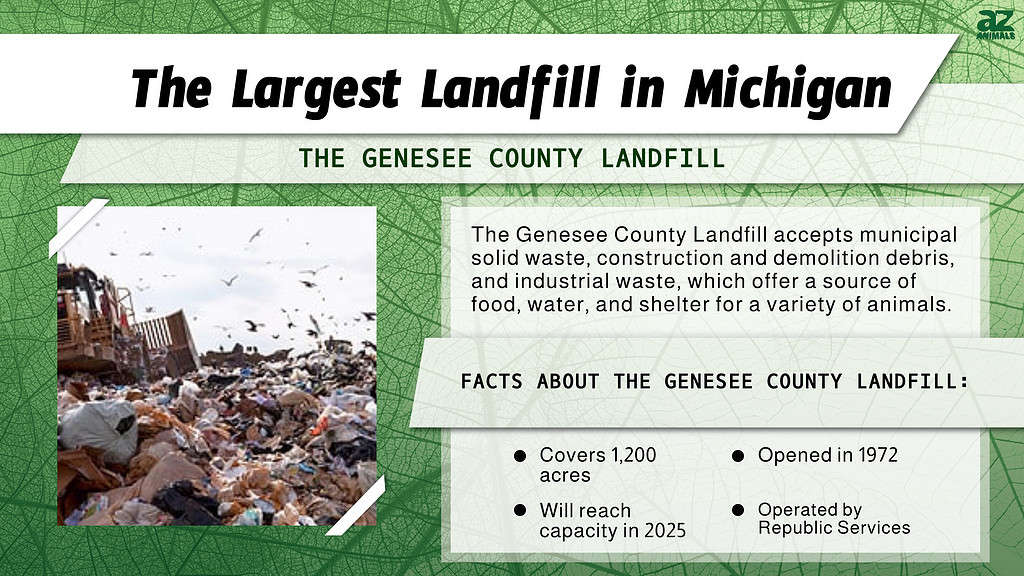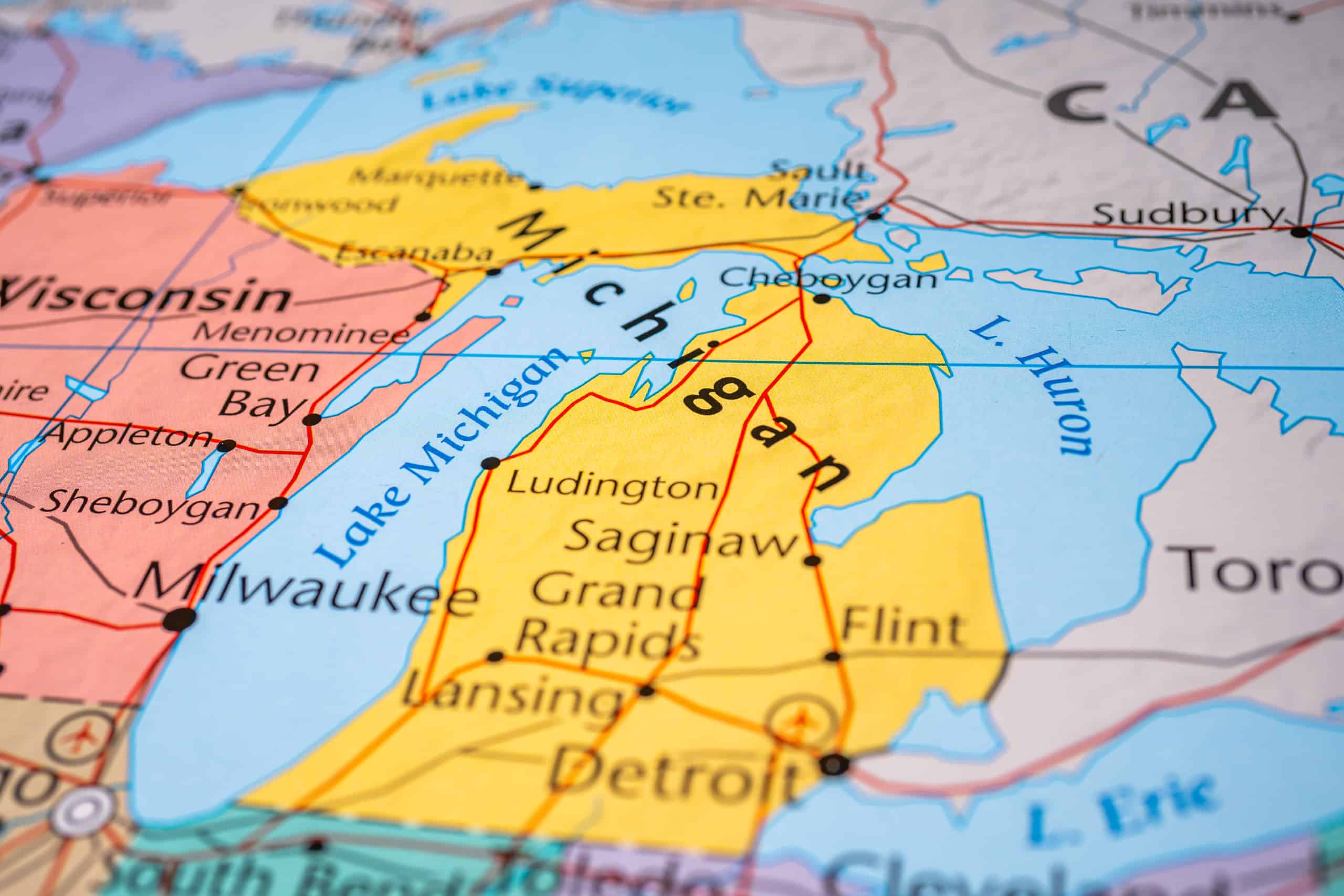When we think about artificial wonders to explore in the state of Michigan, a landfill isn’t typically what comes to mind. However, landfills serve an important purpose and Michigan is home to over 100 of them. Landfills are important because they provide a safe and controlled way to dispose of waste.
They also help to reduce the amount of waste sent to incinerators or other forms of disposal, which can be harmful to the environment. Landfills also create jobs and can generate revenue for local governments.
Landfills tend to develop into a unique ecosystem, attracting a range of fascinating wildlife. In this article, we’ll delve deeper into the largest landfill in Michigan and discover which plants and animals call this unusual habitat home. So, let’s explore the largest landfill in Michigan and the extraordinary creatures that live around it!

The largest landfill in Michigan is the Genesee County Landfill, located in Grand Blanc, Michigan. It covers 1,200 acres and has been in operation since 1972. The landfill accepts municipal solid waste, construction and demolition debris, and industrial waste.
Republic Services manages the landfill. The company has a number of environmental safeguards in place to protect the environment. These include a liner system to prevent groundwater contamination and a gas collection system to capture methane gas, which can generate electricity.
The landfill is expected to reach its capacity in 2025. After that, the state will close it, cap it, and monitor it for environmental contamination for at least 30 years.
History of the Genesee County Landfill
The Genesee County Landfill is a municipal landfill located in Grand Blanc, Michigan. It opened in 1972 and has been accepting municipal solid waste from Genesee County and surrounding areas ever since.
The landfill has a long history of environmental problems. In the 1980s, it leaked methane gas, a greenhouse gas and a fire hazard. The landfill also contaminated groundwater with hazardous chemicals.
In the 1990s, the landfill was placed on the Superfund list, a list of the most contaminated sites in the United States. The landfill has been undergoing cleanup since that time.
The landfill is currently capped with a layer of clay and soil. The cap prevents rainwater from seeping into the landfill and carrying contaminants into groundwater.
Why is the Genesee County Landfill Closing in 2027?
The Genesee County Landfill will close in 2027 because it will have reached its capacity. The landfill has been in operation since 1972 and has accepted over 20 million tons of waste. It is located in a rural area near the city of Grand Blanc, Michigan. The closure of the landfill will have a significant impact on the Genesee County community because it provides jobs for over 100 people and generates millions of dollars in tax revenue each year. The closure will also force businesses and residents to find other ways to dispose of their waste.
What Types of Wildlife Live Around the Genesee County Landfill?
The following wildlife species live around the Genesee County Landfill:
- Birds: American crow, American goldfinch, American robin, barn swallow, black-capped chickadee, blue jay, cardinal, common grackle, eastern bluebird, European starling, house sparrow, mallard, mourning dove, northern cardinal, red-tailed hawk, robin, song sparrow, starling, turkey vulture, and woodpeckers.
- Mammals: American beaver, deer, foxes, raccoons, skunks, and squirrels.
- Reptiles: snakes and turtles.
- Amphibians: frogs and toads.
- Insects: butterflies, dragonflies, grasshoppers, moths, and beetles.
The landfill provides a habitat for these animals, offering a source of food, water, and shelter. The animals that live at the landfill are adapted to the harsh conditions. They play an important role in the ecosystem by helping to decompose waste and recycle nutrients.
Impacts of Landfills on the Environment
Landfills play an important role in our society by helping to protect the environment and create jobs. However, they also have some negative environmental impacts, such as the release of methane gas and the contamination of groundwater. It is important to manage landfills carefully to minimize these impacts.
Here are some additional facts about landfills:
- Landfills are the most common form of waste disposal in the United States.
- The average American generates about 4.4 pounds of trash per day.
- About 54% of all waste in the United States goes to landfills.
- The Environmental Protection Agency (EPA) regulates landfills.
- Landfills are lined with clay or other materials to prevent the contamination of groundwater.
- Landfills must also have a system to collect and control methane gas.
- Landfills are typically closed after they reach capacity and are then covered with dirt and grass.
Typically, landfills serve as municipal solid waste facilities where materials not directed to municipal recovery facilities (commonly referred to as MRFs) are gathered and disposed of through burial. This encompasses items such as food waste, paper, glass, plastics, and other items that could potentially undergo composting or recycling processes.
Where is Genesee County, Michigan, Located on a Map?
Genesee County is on Interstate Highway 75, which runs north and south between Detroit and Bay City. The central city of Flint is intersected by Interstate 69 running east and west and leading southwest to Lansing and East Lansing, home of Michigan State University. Ann Arbor, home of the University of Michigan is straight south on State Highway 23.
In Conclusion
The largest landfill in Michigan proves to be more than just a trash dump. It’s a complex ecosystem that has developed unique characteristics and become a haven for a variety of unexpected wildlife. Though some may overlook the potential it has to offer, exploring this site can provide a new perspective on the environment and the remarkable ways that nature adapts to change. From birds to mammals, insects to plants, the diversity of life around the landfill is impressive, and there’s much to discover and learn from this ecosystem. By doing so, we can gain a deeper appreciation and respect for the ongoing relationship between humans and nature, and develop ways to better manage waste in the future.
Thank you for reading! Have some feedback for us? Contact the AZ Animals editorial team.








